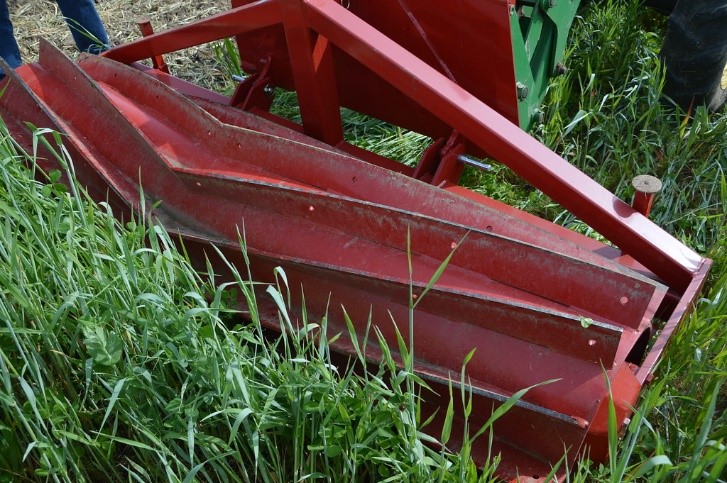Becky Wheeler-Dykes, UCCE Farm Advisor, Glenn, Tehama and Colusa Counties
With the end of harvest comes the beginning of winter prep work. One practice that provides a bevy of positive impacts for orchards is planting a winter cover crop. Adding organic matter to the soil via cover crops can improve water infiltration and water holding capacity of the soil. Fixing nitrogen and breaking up compacted soil can also be achieved by selecting appropriate species for your cover crop mix.
While the benefits of winter cover cropping in orchards are well-known, the particulars of when and how to terminate the cover crop can be overwhelming. Using herbicides to terminate a crop can be expensive, and achieving good coverage can be difficult with large amounts of biomass. Mowing or tilling can disrupt the soil, losing some of the accumulated carbon. Annie Edwards and Margaret Smither-Kopperl with the USDA recently released a report on termination using a roller crimper in orchard systems. Their findings show that, while this can be a great tool to maximize the benefits of cover cropping, roller crimping works best with certain cover crop species and growth stages.

Figure 1. Roller crimper implement. Photo credit: Tracy Robillard, USDA NRCS.
Roller crimping is a common practice in other parts of the country but had not yet been studied in California orchard systems. A roller crimper is a drum-shaped implement with blunt curved blades (Figure 1.) that rolls over and crushes down the vegetation without disturbing the roots. This creates a mat of biomass over the soil’s surface, similar to mulch. This has been shown to reduce soil temperatures, conserve soil moisture, decrease erosion, and reduce herbicide use. The timing of roller crimping is critical; too early and you won’t have enough biomass produced to adequately cover the soil and provide the desired benefits. Too late and the cover crop may have produced seed that can germinate in the current season, depending on irrigation practices and precipitation.
Research completed at the USDA’s Lockeford Plant Materials Center compared four different cover crop seed mixes to determine how well the roller crimper terminated each. Additionally, each of the four mixes was crimped at 6 different times to evaluate which growth stage was most successful for termination. Data on “bounce back” (when plants stood back up and continued to grow) as well as regrowth, biomass, vegetative stage, and cover crop canopy height were collected.
- Results showed that the brassica mix “bounced back” and regrew when roller crimped too early. Termination with the roller crimper was most effective when these species were at least a week into flowering, with termination remaining effective through “seed maturing” stage.This termination timing allowed for good biomass accumulation, and the study notes that the brassica mix formed a vegetative mat when crimped, which is the ultimate goal of this termination technique.
- The fava beans alone remained crimped after the plants had visible early pods reaching about 3/16”. The fava beans and the brassica mix were the only treatments that were completely successfully terminated with the crimper.
- The “annual plow down” mix, consisting of oats, vetch, peas and fava beans, showed best results when crimped at early visible pods in the fava. This mix also had the largest biomass accumulation over the season. However, the oats in the mix had a high rate of “bounce back”. Crimping was not an ideal method of termination for this mix.
- The triticale crop continued to regrow when crimped too early. Crimping was most successful for this species after the plants started to flower. However, even then, the triticale “bounced back” and was never fully successfully crimped.
Ultimately, roller crimping is most effective for termination of cover crop mixes without grass species. Crimping brassica mixes and fava beans produces a vegetative mat that can protect soil and maximize the benefits of cover cropping. It is key to use this technique at the appropriate vegetative growth stage for the species in your mix, as crimping too early can necessitate repeating the practice.
The entire USDA report, including seeding densities, seed sources, and photos can be found here.


Leave a Reply